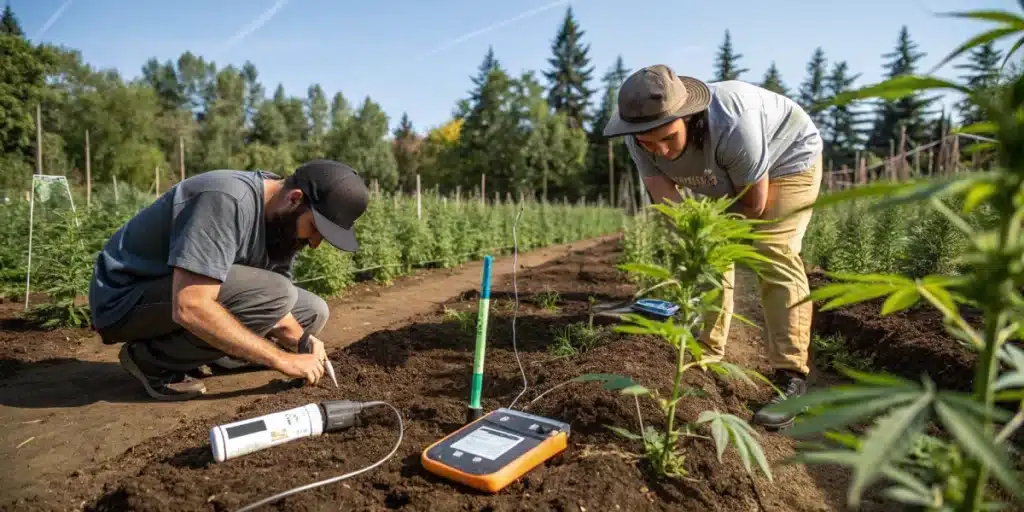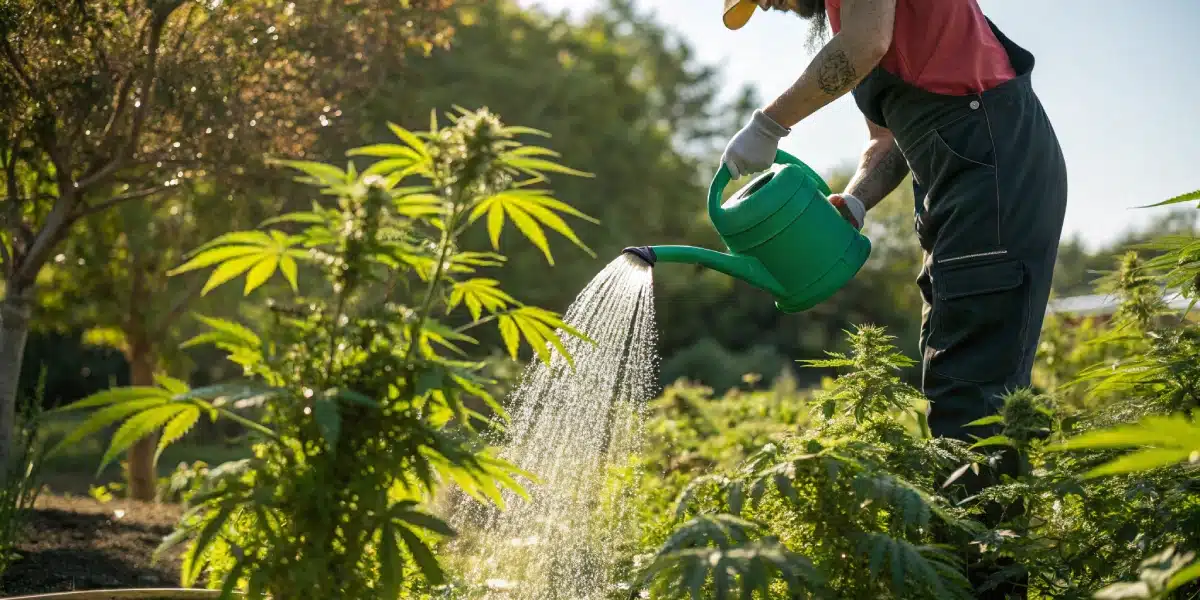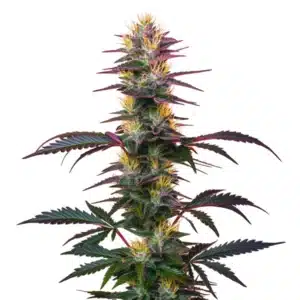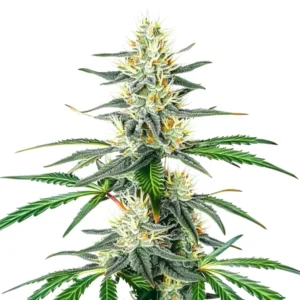
Fertilizing Outdoor Cannabis: When and How to Feed Your Plants
Mastering fertilizing outdoor cannabis can transform your garden into a vibrant, high-yielding oasis. Skilled growers know that proper feeding schedules, attentive observation of plant signals, and accurate nutrient application techniques enable your plants to thrive in open-air environments. The practice of fertilizing outdoor cannabis ensures that your plants receive a balanced nutrient mix for robust growth and enhanced flower production.
Using active techniques to maintain nutrient levels, growers adopt methods tailored for outdoor setups that address weather variability and soil composition. This guide presents expert advice on feeding your plants throughout the vegetative and flowering phases while maintaining healthy, vigorous growth.
Recommended Strains
Gush Mints
|
|
THC | 31% - 34% (High) |
|
|
Type | Feminized |
|
|
Yield | High |
|
|
Phenotype | 50% Indica / 50% Sativa |
Gushers
|
|
THC | 22% - 25% (Medium) |
|
|
Type | Feminized |
|
|
Yield | Medium |
|
|
Phenotype | 60% Indica / 40% Sativa |
Signs Your Plants Need Feeding for Fertilizing Outdoor Cannabis
Visual Symptoms Indicating Fertilizing Outdoor Cannabis
Observing the vibrant hues and structure of your plants often reveals when it is time for nutrient intervention. Yellowing leaves, stunted growth, or uneven coloration signal that your outdoor cannabis may lack essential nutrients. Experienced cultivators check for leaf curling and burn marks that sometimes result from improper feeding routines.
Plants that thrive outdoors express subtle yet clear signals when their nutrient demands are unmet. Growers may notice that newer leaves remain pale or that older foliage begins to fade in color. By monitoring these visual symptoms, you can adjust your feeding strategy to restore balanced nutrient levels while ensuring a smooth transition between growth phases.
Checking Soil Nutrient Levels for Fertilizing Cannabis Outdoors
Regular soil testing reinforces your understanding of when and how much to feed. Utilizing pH meters and nutrient probes enables you to confirm deficiencies or imbalances in your garden’s substrate. Accurate testing ensures that every application aligns with the plant’s current developmental stage.
Gardening experts advise scheduling routine soil analyses, particularly after extreme weather events that might flush out vital minerals. Data-driven decisions lead to tailored feeding regimens that maintain the health and productivity of your outdoor crop.
Promos & Deals
Feeding Schedule: Optimizing Fertilizing Cannabis Outdoors from Vegetative to Flowering
Feeding During the Vegetative Phase
A well-planned schedule begins in the vegetative stage when plants demand a higher proportion of nitrogen. During this phase, feeding strategies for fertilizing cannabis outdoors focus on rapid cell growth, sturdy stems, and expansive foliage. Active nutrient absorption during this period supports vigorous development that lays the groundwork for future flowering.
Growers implement regular feeding intervals, adjusting application amounts based on environmental factors such as soil type and ambient temperature. Precision in dosing ensures that every nutrient is efficiently utilized, thus promoting robust root systems and healthy leaves.
Adjusting Nutrient Intake for Flowering
When plants transition to the flowering phase, they shift their needs from leafy growth to bud development. A refined approach to fertilizing cannabis outdoors during this period replaces nitrogen-rich formulas with those higher in phosphorus and potassium. The focus on these nutrients results in dense, resinous flowers that capture attention.
Active scheduling helps balance nutrient uptake without overwhelming the plant. Growers monitor plant responses to fine-tune the concentration and frequency of feedings. This proactive attitude in adjusting the nutrient profile ensures that outdoor cannabis blossoms with enhanced potency and aroma.
How to Apply Fertilizers for Fertilizing Outdoor Cannabis
Liquid Application for Fertilizing Outdoor Cannabis
Many cultivators favor liquid fertilizers for their ease of application and rapid absorption. Applying nutrients in liquid form allows a fast and even distribution of essential minerals across the root zone. This method gives outdoor cannabis immediate access to the elements it needs for steady growth.
Farmers mix liquid concentrates with water, ensuring that the blend remains uniform for each application. The active circulation of water through the soil promotes a balanced nutrient environment that supports both new growth and mature plants. Regular use of liquid feedings maximizes efficiency and minimizes waste.
Granular Application Methods for Fertilizing Cannabis Outdoors
Granular fertilizers serve as a slow-release source of nutrition, gradually making nutrients available over time. This method benefits outdoor gardens by offering sustained feeding during periods when watering is less frequent. Growers often scatter the granules evenly around the base of the plants, ensuring proper integration with the soil.
Experts advise lightly incorporating granules into the top layer of soil to facilitate faster nutrient release. This approach minimizes runoff and protects the integrity of the root structure. Active monitoring of soil moisture enhances the effectiveness of granular applications while preserving plant health.
Avoiding Overfeeding and Burn in Fertilizing Outdoor Cannabis
Recognizing Overfeeding Signs in Fertilizing Outdoor Cannabis
Overfeeding poses risks such as nutrient burn, which can manifest as scorched leaf edges and discolored foliage. Attentive growers check for these symptoms early, ensuring that nutrient application does not exceed plant capacity. Maintaining a regular schedule and moderate dosages prevents sudden spikes in nutrient concentration.
Visual inspections remain a reliable tool to detect signs of overfeeding. Active record-keeping and soil testing help you track nutrient levels over time. Early intervention preserves plant vigor and prevents long-term damage caused by nutrient toxicity.
Best Practices in Preventing Nutrient Burn while Fertilizing Cannabis Outdoors
Employing a balanced feeding regimen actively prevents nutrient burn. Growers adjust concentrations and volume according to weather fluctuations and plant growth stages. Diligence in reading product labels and following manufacturer guidelines ensures a measured approach.
Routine flushing with water further safeguards against salt buildup in the soil. Active use of water management techniques flushes out excess fertilizers, preserving the plant’s natural resilience. This proactive method not only prevents burn but also enhances overall nutrient uptake.
Expert Tips for Fertilizing Cannabis Outdoors Effectively
Experts recommend scheduling feedings early in the day, allowing nutrients to integrate during peak sunlight hours. Active monitoring of both soil moisture and nutrient levels prevents discrepancies between feeding sessions. Observing weather forecasts and adjusting application rates further improves outcomes.
Additional guidance emphasizes patience and consistency. Growers often start with lower doses and gradually increase feedings as the plants mature. This approach actively minimizes shock and enables a smoother transition between developmental phases.
Choosing the Right Fertilizer for Fertilizing Outdoor Cannabis
Organic vs. Synthetic Options in Fertilizing Outdoor Cannabis
Gardeners actively compare organic and synthetic fertilizers to determine which suits their outdoor environments best. Organic fertilizers, derived from natural sources such as compost or fish emulsion, provide a gentle nutrient boost without overwhelming delicate root systems. In contrast, synthetic options deliver fast-acting nutrients in concentrated doses.
Each option has distinct advantages. Organic alternatives typically promote soil health and long-term fertility, while synthetic fertilizers offer precise control over nutrient ratios. Active research and experimentation allow cultivators to blend approaches, resulting in an optimal mix tailored to their specific outdoor conditions.

Nutrient Ratios for Fertilizing Cannabis Outdoors
Proper feeding requires awareness of nutrient ratios. Growers often refer to N-P-K values to tailor their feeding regimen. Active adjustments in the ratios during different growth stages ensure that outdoor cannabis receives the appropriate amounts of nitrogen, phosphorus, and potassium at the right time.
Paying attention to these numbers prevents imbalances that might stress the plants. Active record-keeping of the applied nutrient ratios aids in refining future feeding schedules. This method empowers growers to build a sustainable nutrient management plan that supports high-quality yields.
Environmental Considerations for Fertilizing Cannabis Outdoors
Weather Impacts on Fertilizing Outdoor Cannabis
Weather exerts a significant influence on nutrient uptake. Heavy rains can leach nutrients away from the root zone, while prolonged dry spells might hinder absorption. Active scheduling of feedings around weather patterns protects outdoor cannabis from sudden nutrient deficits or excesses.
Seasonal forecasts prompt growers to modify their feeding routines. Active responses to temperature and humidity changes help maintain soil stability and support consistent plant growth. This attentive approach allows for seamless adjustments in feeding regimens as conditions evolve.
Soil Types and Local Conditions in Fertilizing Cannabis Outdoors
The quality of soil plays an active role in nutrient availability. Sandy soils may require more frequent feedings due to rapid drainage, while clay-rich soils retain nutrients longer. Understanding local soil conditions enables you to customize your feeding strategy for maximum efficiency.
Active amendments such as adding organic matter or adjusting pH levels help optimize nutrient absorption. Growers often invest in local soil tests to tailor their nutrient applications accurately. This focus on environmental factors results in outdoor cannabis that consistently meets its growth potential.
Practical Strategies for Sustainable Nutrient Management
Integrating Natural Amendments and Compost
Integrating natural amendments supports both soil fertility and plant health. Using well-composted materials introduces beneficial microorganisms into the soil while providing steady nutrient release. Active integration of compost and organic matter proves beneficial when practicing fertilizing outdoor cannabis.
Balancing synthetic fertilizers with natural compost fosters a sustainable growing environment. Growers embrace this dual strategy to achieve resilient plants and healthy soil ecosystems. This approach enables a consistent nutrient cycle that sustains plant growth over long periods.
Adapting Feeding Techniques to Changing Seasons
Seasonal variations demand flexible nutrient management strategies. Active growers adjust feedings to match the intensity of sunlight, temperature shifts, and rainfall patterns. Adapting techniques such as reducing fertilizer strength during cooler periods preserves soil quality.
Detailed planning and observation allow you to implement proactive changes in your feeding schedule. Timely adjustments ensure that outdoor cannabis benefits from nutrient applications without suffering from imbalances or burn.
Enhancing Yields with Select Strain Nutrition
Strain-Specific Nutrient Considerations
Different cannabis strains may exhibit unique nutrient requirements. Active cultivation practices encourage testing various feeding regimens on select strains. For example, growers sometimes incorporate unique genetic traits from strains like Super Boof Auto, which thrives with moderate nutrient boosts. These targeted practices help refine feeding routines.
Other strains such as Fat Bastard Strain benefit from balanced fertilizer mixes during peak growth, while varieties like Bubble Gum Sherb Strain Seeds show marked improvements when fed with specific nutrient ratios. Tailoring your feeding strategy to the genetic makeup of your crop drives robust yield and flavor profiles.
Balancing Yield and Potency Through Feeding Regimens
Growers actively prioritize both yield and potency by adjusting feeding regimens to meet the unique needs of each strain. A focus on balanced nutrient application results in high-quality buds that boast superior resin content and aroma. Active testing across different strains sharpens your approach to feeding outdoor cannabis.
Regular observation and record-keeping empower cultivators to tweak feeding protocols based on plant performance. This attention to detail ensures that every strain in your garden reaches its full potential, producing premium yields that satisfy both flavor and potency standards.
Fine-Tuning Your Approach for Long-Term Success
Monitoring Plant Health and Adjusting Nutrient Inputs
Active monitoring of plant health remains the foundation for successful nutrient management. Regular inspections of leaf color, texture, and overall vigor reveal subtle shifts in nutrient uptake. Adjusting inputs based on these observations maintains a consistent feeding schedule that adapts to both plant and environmental changes.
Maintaining detailed logs and scheduling routine soil tests empower you to refine your methods over time. The feedback loop between observation and application drives sustainable growth, ensuring that every feeding session contributes positively to your garden’s performance.
Incorporating Feedback from Seasonal Variations
Seasonal feedback influences adjustments in nutrient levels and feeding frequency. Active record-keeping helps correlate weather patterns with plant performance, guiding timely modifications in your regimen. Recognizing how seasonal shifts affect nutrient absorption allows for smarter feeding practices.
Long-term success depends on a willingness to adapt and refine your techniques. Embracing this proactive mindset yields resilient, healthy plants that flourish regardless of environmental challenges.

Expert Strategies for Mastering Fertilizing Outdoor Cannabis
Creating a Detailed Nutrient Calendar
A detailed nutrient calendar organizes feeding sessions, tracks nutrient types, and notes environmental conditions. Active planning with a calendar allows you to schedule feedings, anticipate weather impacts, and adjust dosages systematically. This structured approach minimizes mistakes and maximizes plant health.
By integrating scheduled tasks and regular monitoring, you develop an efficient system for managing nutrient inputs. Growers who commit to detailed planning enjoy consistent growth and superior yields, as every feeding session contributes strategically to the plant’s development.
Embracing Technological Tools for Precision Feeding
Modern technology offers smart sensors and automated timers that simplify the nutrient management process. Active integration of these tools enhances accuracy, ensuring that outdoor cannabis receives precise doses at optimal intervals. Automated systems help reduce human error and support consistency.
Data-driven decisions become easier when you incorporate real-time feedback from technological aids. This proactive adoption of modern tools refines your feeding schedule and ensures that every nutrient application meets the plant’s requirements with pinpoint precision.
Refined Techniques for Long-Term Outdoor Cannabis Success
Maintaining a Consistent Growth Environment
Stability remains key when managing an outdoor garden. Active nutrient management involves creating an environment where plants grow steadily despite weather fluctuations. Consistency in feeding practices preserves soil integrity and promotes vigorous plant development.
Regular care and timely adjustments foster a resilient outdoor cannabis garden. Growers who maintain consistency in their approach witness sustained growth, robust yields, and improved flower quality over multiple growing seasons.
Sharing Knowledge and Community Best Practices
Engaging with fellow cultivators provides fresh insights and innovative feeding strategies. Active community discussions and shared experiences help refine techniques for fertilizing outdoor cannabis. Peer advice often introduces new methods and fertilizers that you might not have considered otherwise.
Participating in cultivation forums and local grower groups nurtures a culture of continuous improvement. Active exchange of ideas creates a supportive network that benefits everyone involved, ensuring that best practices spread throughout the community.
FAQs
How often should I fertilize my outdoor cannabis?
Fertilization frequency depends on the plant’s stage and local soil conditions. Many experienced growers suggest a feeding schedule that aligns with the plant’s growth phases, ensuring that nutrient uptake matches developmental needs.
What are the signs of nutrient burn?
Nutrient burn typically presents as scorched or yellowing leaf edges and discolored foliage. Monitoring these symptoms early can help you adjust your feeding regimen to prevent further damage.
Can I mix organic and synthetic fertilizers for fertilizing cannabis outdoors?
Yes, combining organic and synthetic fertilizers can offer a balanced nutrient profile. This blend leverages the slow-release benefits of organic matter with the precise dosing of synthetic nutrients, supporting robust growth and sustained yields.



















